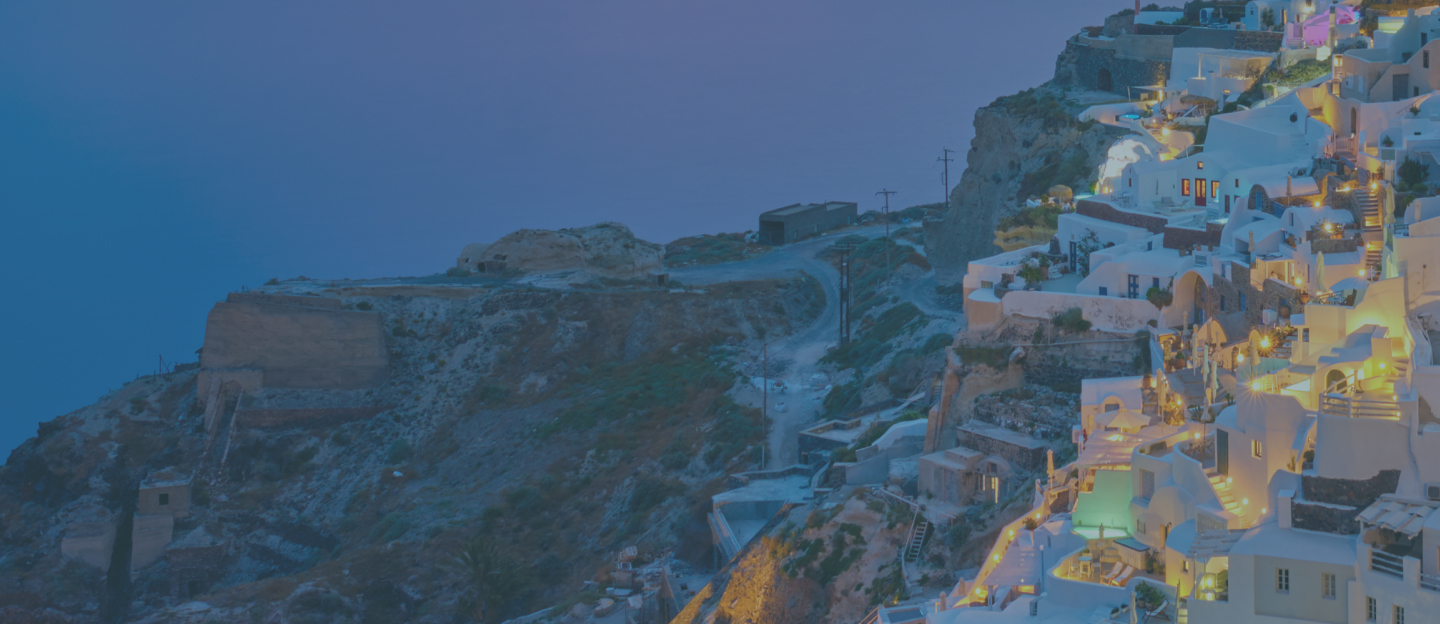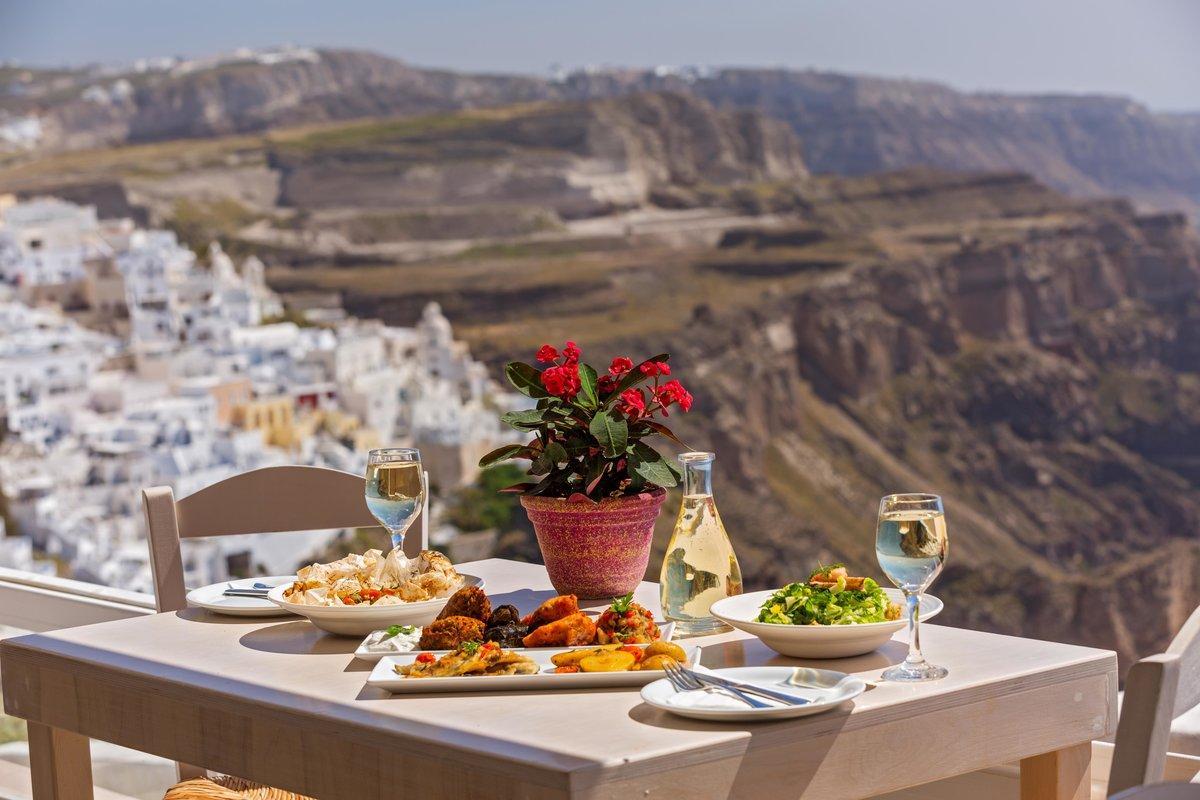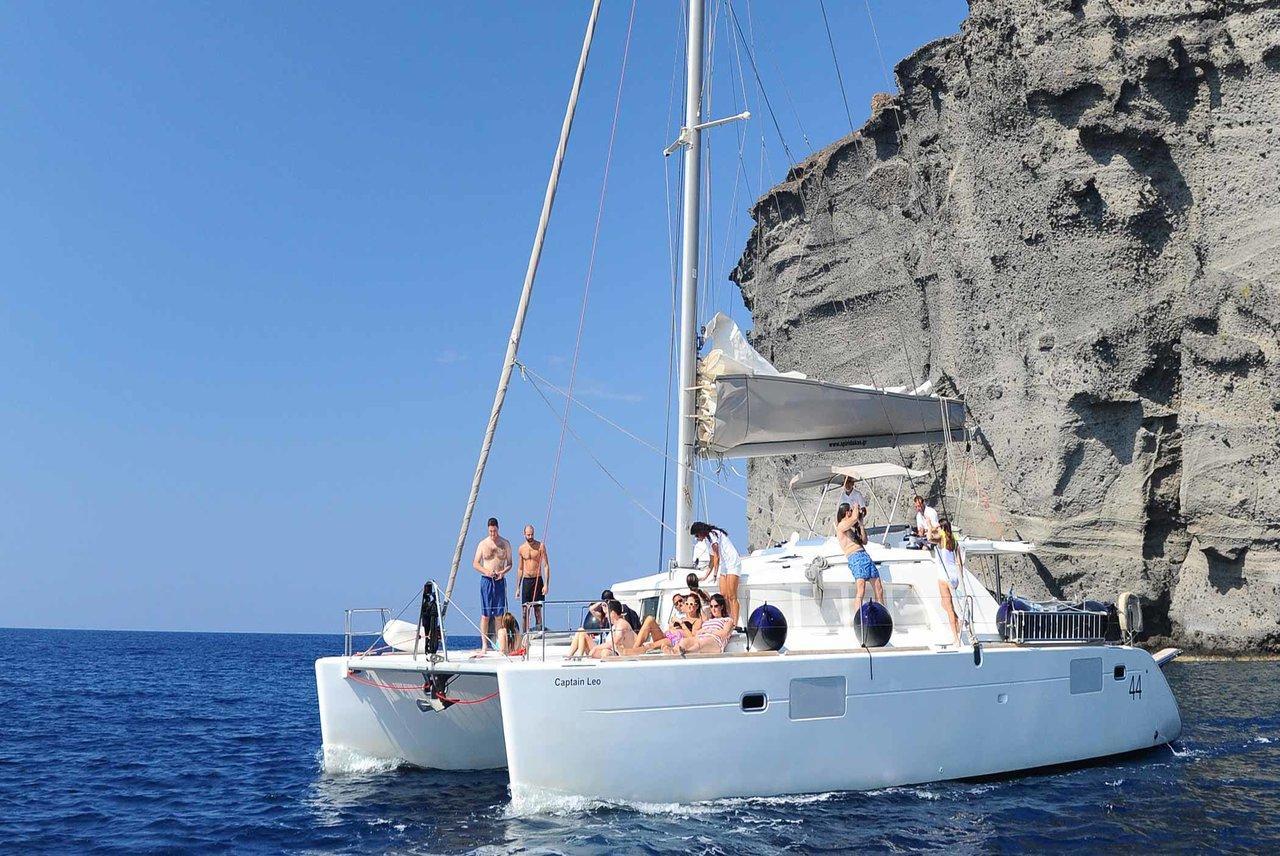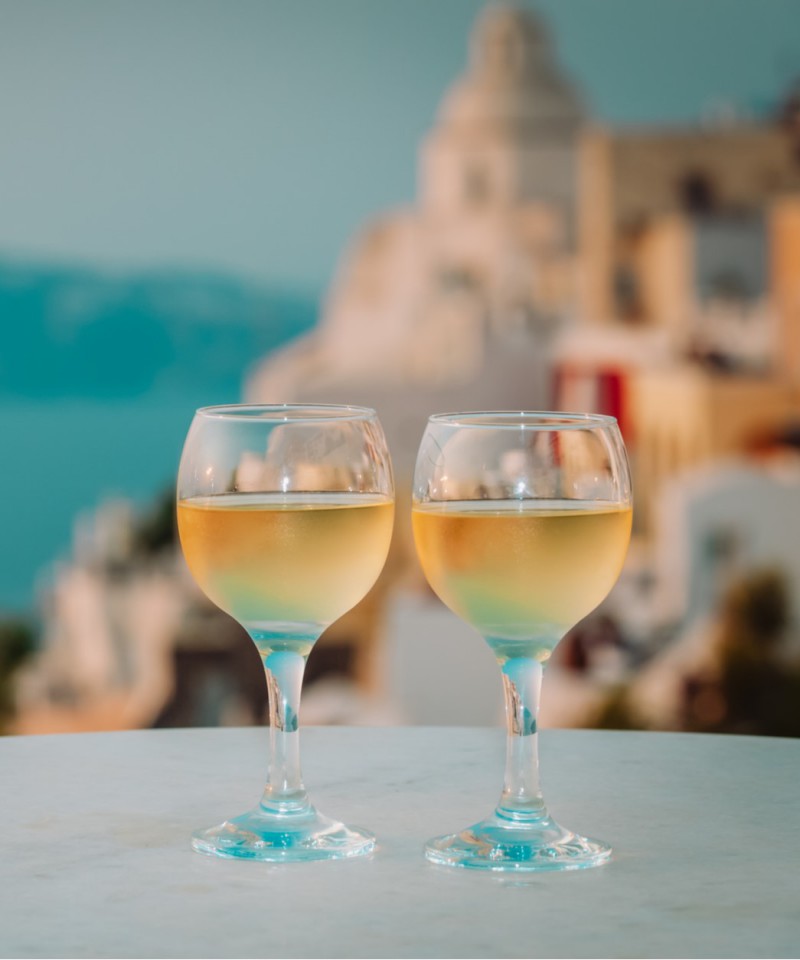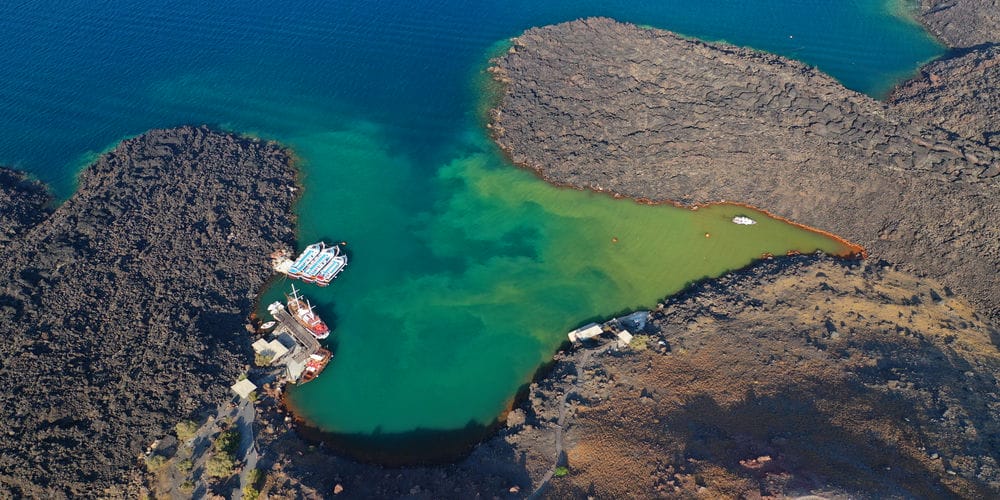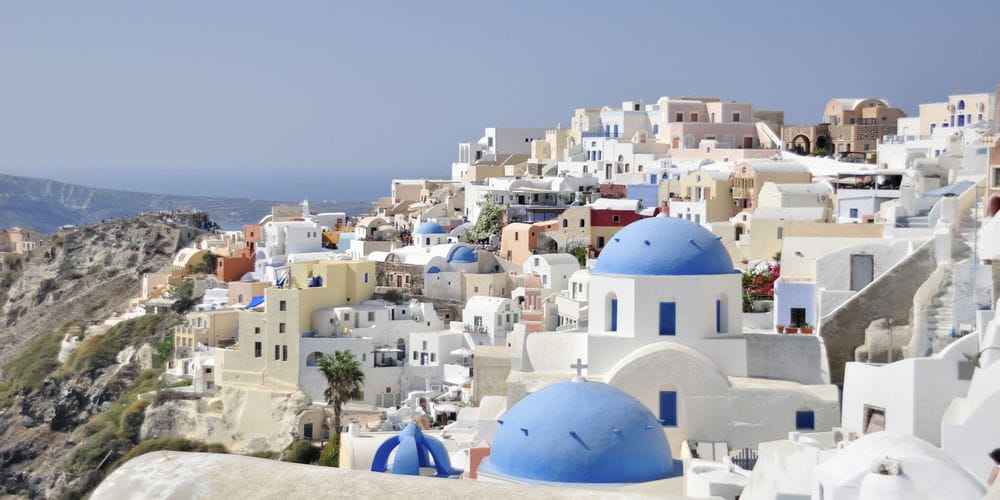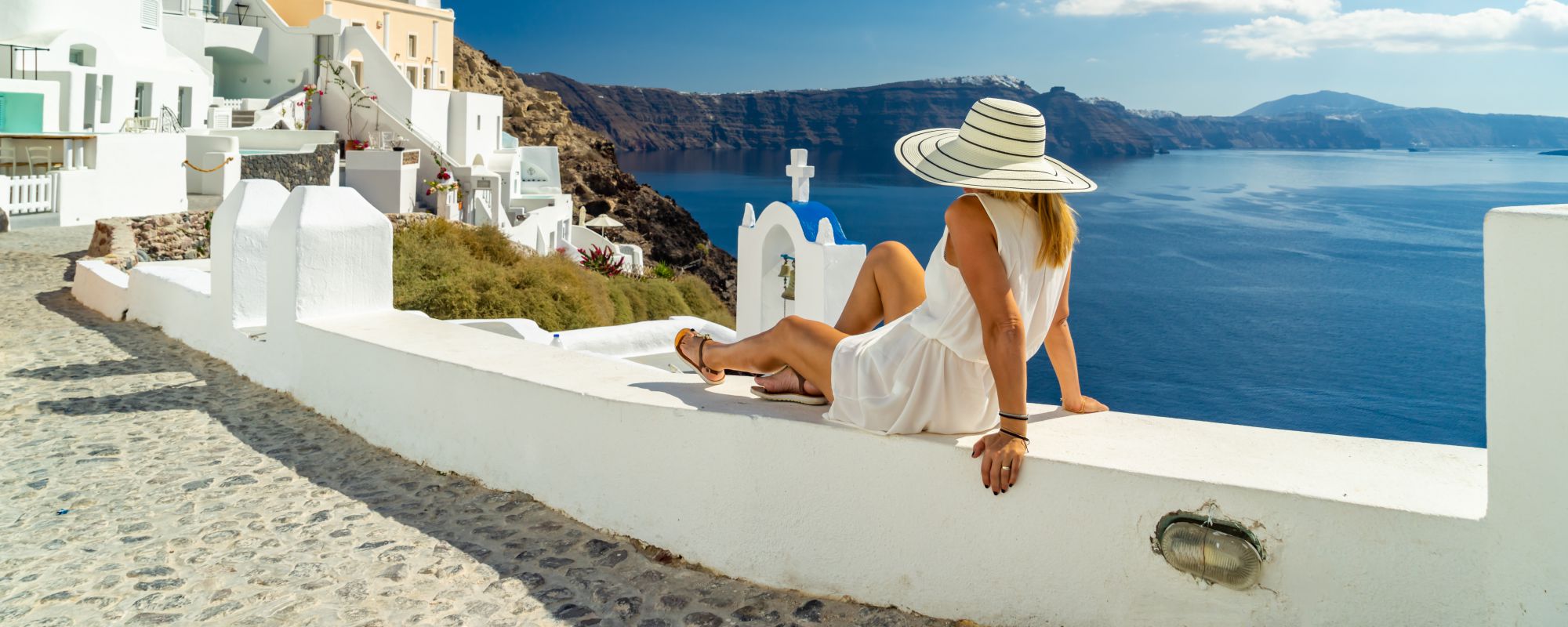
Guide to Oia, Santorini
Key Takeaways
- Oia is known around the world for its stunning panoramic views of the Santorini caldera and the Aegean Sea.
- Oia exudes a romantic ambiance that makes it a very popular destination among honeymooners and couples in love.
- Oia showcases the traditional Cycladic architecture with its distinctive white buildings and blue-domed churches, which add to the village's charm and allure.
- Oia offers a wide range of boutique shops and local restaurants where visitors can indulge in shopping and tasting delicious Greek food.
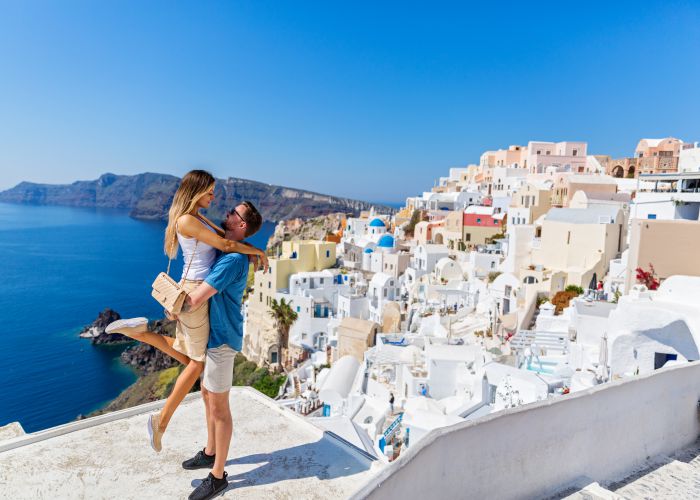
What comes to mind when thinking about the stunning Greek island of Santorini? The unique natural landscape and the magical sunset in Oia, obviously.
The popular destination, however, has much more to offer locals and visitors alike. Its history and cultural heritage are of great interest.
However, the massive number of tourists who arrive from Athens to Santorini annually don't always get the opportunity to experience the settlement of Oia to its full potential.
Oia is a famous tourist town and a charming city. It is a necessary stop during your visit to the island, even if you don't choose it for your accommodation, and visiting it is one of the most popular things to do in Santorini, especially if you're on your Santorini honeymoon. On the northwest coast, the island is situated at a 60 - 160 meters altitude above sea level.
These characteristic white buildings extend approximately 1.5km (1mile) along the cliff. From the west, Oia lies close to the picturesque fishing town of Amoudi. A few kilometers north of the settlement are the ports of Armeni and Finikia in the south.
About Oia Village
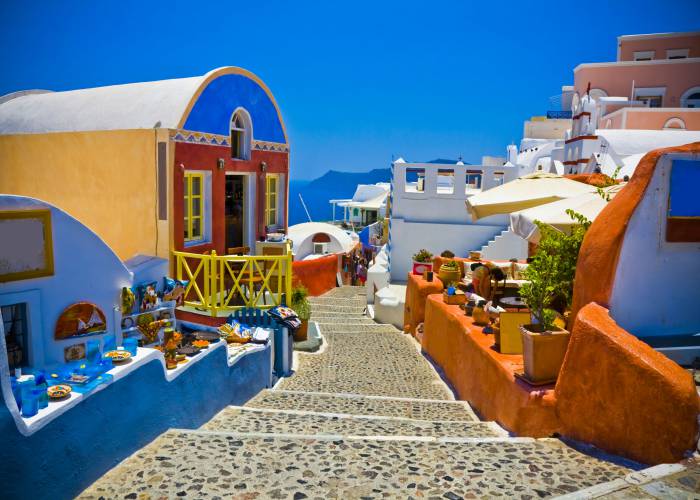
Perched along the northern edge of the Islands and built on a limestone hillside, Oia is the picturesque and romantic town everyone dreams of visiting, even if they're traveling to Santorini with kids.
On the south side, Oia overlooks the caldera with Santorini views of the Nea Kameni volcano and the Thirassia island. This section of Oia's northern part is far off Caldera and is renowned for its stunning sunsets and ocean views.
Oia village offers some of the island's best hotel and restaurant options. The panorama of Greek architecture cascading into the ocean, blue domes, beautiful windmills, and colorful streets - all framed by the golden sunset, make Oia, Santorini, paradise on earth.
Important Distances from Oia, Santorini
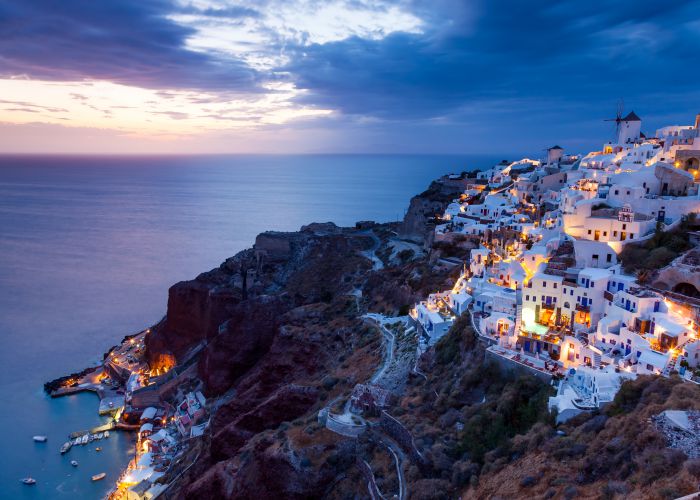
Oia may not be the capital of the island. It still, however, is a central spot that proves to be convenient in regard to transportation in Santorini.
Oia is 15 km from Fira, Santorini's capital, and 13 from the scenic settlement of Imerovigli. It is also 23 km from Perissa and 19 km from Kamari. What's more, the settlement of Oia is 17 km from the airport and 19 km from Santorini's port.
All in all, there is no part of Santorini you can't access from Oia within half an hour.
The Terrain of Oia, Santorini
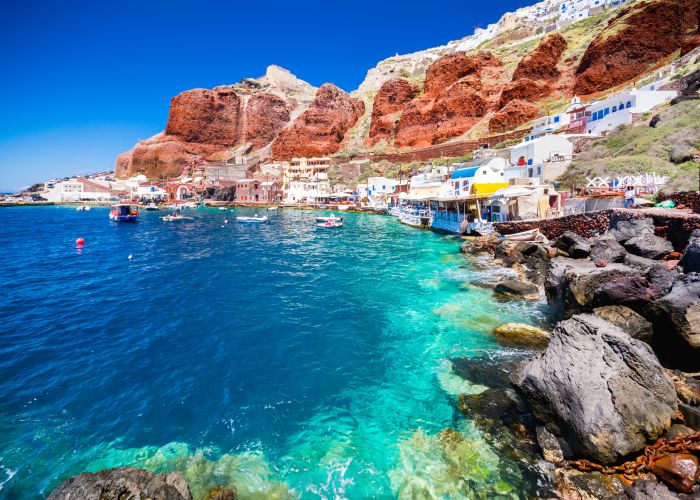
The architectural forms and urban development of both Oia and the entire island is due to the greatest extent to the quality of the soil. Most of Santorini consists of volcanic rocks with excellent properties. The local materials that are mined from the ground and define the structures are:
- the black stone, an extremely hard rock with enormous resistance.
- the solid Redstone.
- the spongy Redstone, which allowed the construction of domes due to its lightweight consistency.
- the 'kissiri' or pumice stone replacing spongy pumice since 1925.
- white or theraic earth, the most important building material.
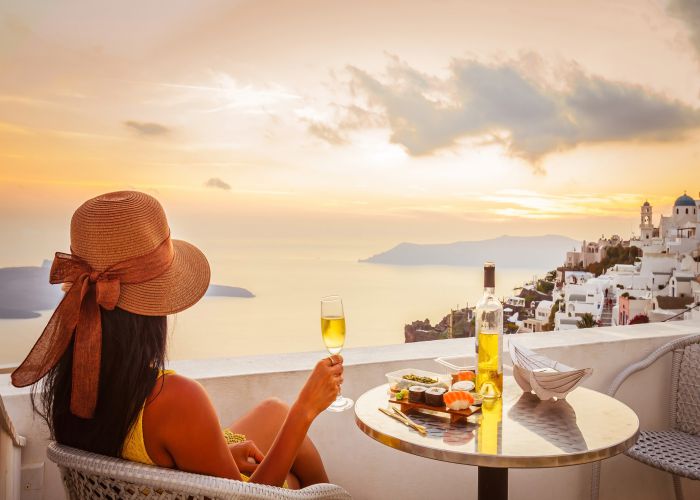
In general, Santorini and, by extension, Oia is dry, without lakes and rivers. Therefore the vegetation is rudimentary and limited to shrubby plants.
Its irrigation needs are mainly covered by boreholes made in its subsoil, where rainwater mainly collects. There are three main springs and four thermal springs on the island.
Its terrain is volcanic, lowland in part, which favors the cultivation of vines, fava beans, tomatoes, and the local eggplant, and rocky on the side of the volcano.
The micro-climate of Oia, Santorini

Two main microclimates can be observed in the settlement of Oia: the caldera and the plain part of Oia, where the captain's houses are developed.
In the caldera area, the climate is very warm, which is justified by its southern and western orientation and the strong slope of the ground that protects it from the north.
On the contrary, in the plain part, the disproportion between the width of the sidewalk and the height of the buildings is observed, preventing its direct sunlight. At the same time, its simultaneous exposure to the north west edge makes the area colder.
The history of Oia, Santorini
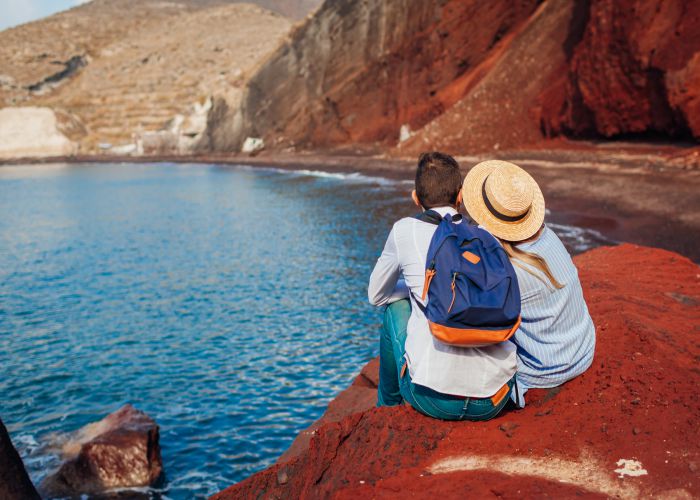
An old and fascinating history inhabits Oia. The turn of the century has been regarded as being arguably the time for its greatest prosperity, as its economic system relied mostly on trade in the maritime trade a large number of merchant vessels inhabited Oia.
The settlement got its current name, "Oia," in the 1930s since it was previously called Epano Meria or Kasteli of Agios Nikolaos.
We know that the Byzantine Castle of Agios Nikolaos already existed since 1480, during the period of the Latin occupation, while its location was in the western part of the current settlement.
Outside there was Goulas, a tower of great height, which during the 15th-18th century had the use of an observatory for pirate raids. Unfortunately, today, due to the great earthquake in 1956, only its base is preserved.
During this period, Oia had developed as a defensive core, and its rulers were the Dargenta, Latinized Greeks who claimed descent from the Byzantine emperor Romanos Argyros. They remained sovereign of Pano Meria until 1577. In 1579 the Duchy of the Aegean passed into the hands of the Ottomans.
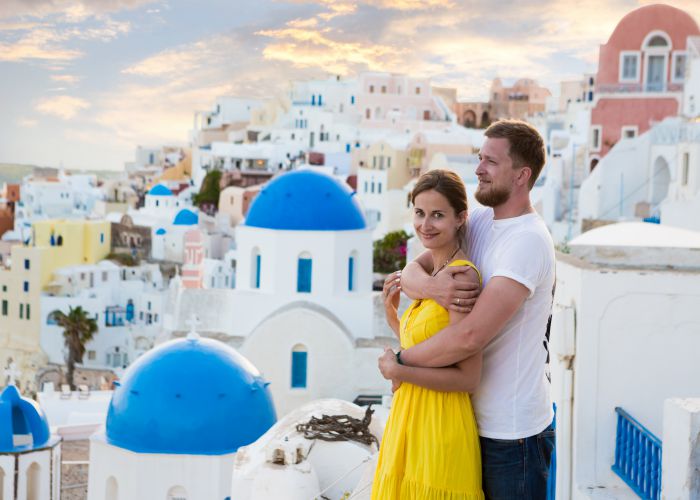
Like the whole island, Pano Meria became their vassal for 250 years. Then the countdown to Pano Meria began. As the pirate raids continued, the population dwindled, and the castle could not protect the inhabitants.
In 1650, the underwater volcano of Kouloumbo erupted on the NE side of Oia. This volcanic activity lasted two months. It was accompanied by earthquakes and eruptions of volcanic ash, claps, and thunder that could be heard from as far as Chios island.
We find references to Oia in the writings of travelers from 1650 during the period of the Frankish rule in Greece. At that time, Oia was one of the five castles of Santorini and was called the Castle of Agios Nikolaos.
The characteristic of the castles was that the houses were built in a row, attached to each other, in a perimeter arrangement, with windows and entrances from the inner side of the settlement. This protected the inhabitants from enemy raids. Usually, in each castle, there was a unique entrance. The other four castles were Skaros, Pyrgos, Niborio, and Akrotiri.

Oia was the well-known captain village of Santorini, which experienced great economic growth until the 19th century.
Its power came from the development of a powerful navy with strong trade relations with major centers in the Eastern Mediterranean and as a transit center for trade with centers such as Russia and Alexandria.
The dynamic fleet in 1856 amounted to 269 ships, which belonged to residents of the settlement, while at the same time, a small shipyard was operating in Armeni Bay. These shipowners were also the powerful economic class of Oia.
This element is also reflected in the architectural types of the captain's houses at the top of the caldera. At the same time, there were 13 different parishes in Oia, a bank, a customs office, many small craft centers, and large agricultural production.
Its great plain produced wonderful varieties of vines, and wine was exported in large quantities even to France.
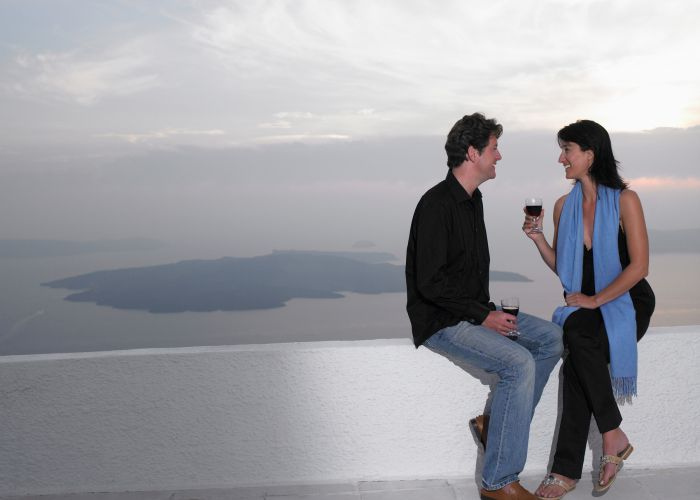
It was loaded onto sailing ships mainly in the fishing village of Ammoudi, whose buildings served as warehouses. The gradual predominance of steamships did not leave Oia's shipowners unmoved, who forcefully invaded world shipping.
During World War II, the settlement was under Italian and German occupation. With the appearance of steamships at the end of the 19th century, the development of Santorini was irreparably affected by the transfer of all production units to centers of Greece, such as Piraeus. At the same time, the earthquakes of 1956 left the settlement in a tragic state.
Most of it fell into ruins, with a population of around 200 by the end of the 20th century. Many factors are responsible for the decline: the earthquakes of 1928 and 1956, the winter of 1942, and the closing of the Darzenda hosiery in 1956-57. The inhabitants of Oia migrated to Piraeus and Lavrio.
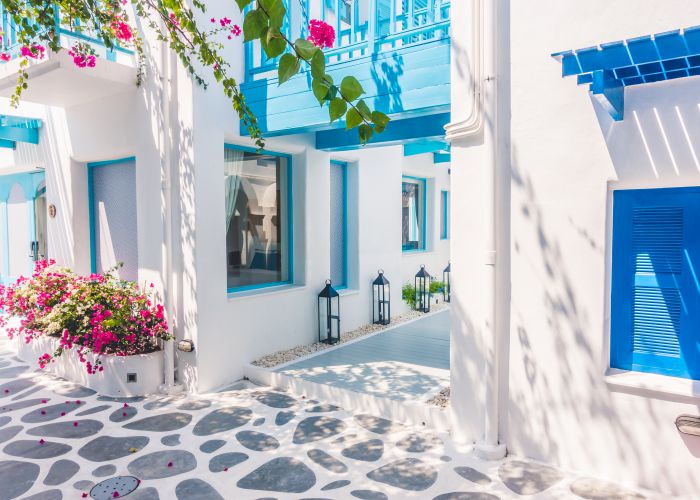
In 1976, Oia joined the EOT program for the 'Development and exploitation of Traditional Settlements.' The architect Voula Bozineki-Didoni was responsible for Oia's settlement for 16 years (1976-1992). The program's purpose was the restoration of traditional dilapidated buildings and their utilization as tourist accommodation.
- 80 houses with a capacity of 200 beds were repaired and managed by EOT for a few years before being returned to the rightful owners.
- The first drainage network was formed as well as a water tank in Ammoudi.
- The weaving mill was created in which many women of the region were employed
- The Naval museum was established in a restored captain's house. Photographs of captains, wooden prows, tools from the Carnaia, watercolors of the Oatian ships, and old charters are some of the museum's exhibits that testify to the great maritime development of the settlement.
- Significant examples of traditional architecture, such as churches, mills, and canvases, were restored.
- An old coffee shop was transformed into an EOT office.
- The retaining wall of the slopes of Ammoudi and the pedestrian path leading across from the islet of Agios Nikolaos were built.
The volcano
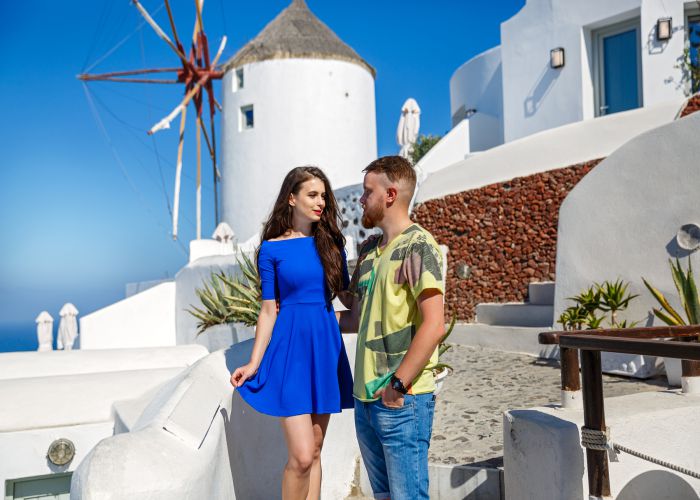
The Santorini volcano is one of the largest underwater active volcanoes in the world. It is perhaps the only volcano whose caldera reaches the sea.
The shape of the island, as well as the morphology of the land, are due to the intense volcanic activity. The oldest volcanic centers are located in the area of Akrotiri, in southwest Santorini, while 50,000 years later, the volcano of Peristeri was formed between Thirasia and northern Thira, as well as other smaller ones.
The volcanic activity formed a huge cavity, where the sea penetrated, and it was called a caldera (cauldron in Italian). Its greatest eruption occurred during the Minoan Bronze Age in 1650 BC when Strogyli was united with a central caldera.
The entire center of the then circular island was submerged in the sea during the terrible volcanic eruption. The eruption caused a tidal wave that wiped out the advanced civilization of Minoan Crete, 70 miles south of Santorini.
During the volcanic eruption, a huge mass of pumice was ejected and covered the surface of the sea in most of the surrounding areas of the Aegean, which seems to have drifted to the surface of the sea. The precipitation of the volcano formed the current caldera, where Palaia and Nea Kameni were later formed.
The architecture of Oia, Santorini; its cave houses and blue-domed churches
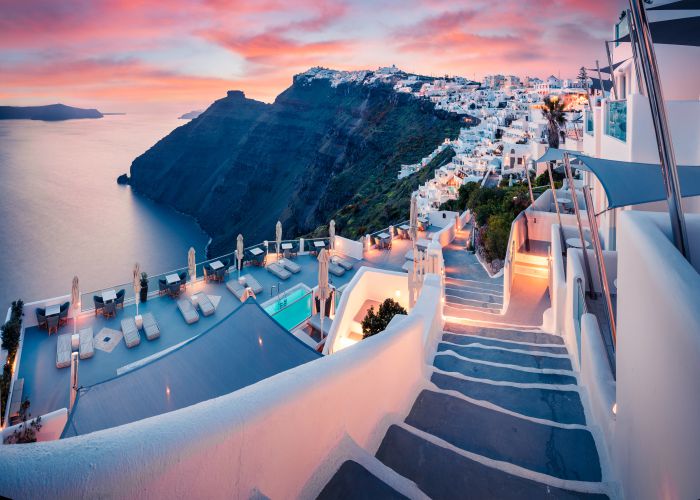
Oia seems to be lined up along the caldera ridge while it continues to spread towards the sea with a more fluid morphology. Following a system of cast architecture, the built space is perfectly harmonized with the intense relief of the rocks following their strong folds.
The vernacular architecture originates from the peculiar environment of the area, with the buildings having a direct interaction relationship with it and creating the impression of emerging from the volcanic terrain.
The contribution of the main construction material is important, which is a mortar with volcanic ash as the main component, the soil itself.
As a result, the environment itself is redefined with conservative and limited human intervention creating living spaces. Therefore, the residence and buildings are an extension of the land that hosts them.
The settlement develops in two general areas, the caldera area, and the upper, flat area. In the first section, you can find the architectural type of hollow and half-built buildings, the folk houses belonging to Oia's poor workers.
Cave houses were developed due to the easy construction and to save the fertile land. In the second area are the mansion houses of the Captains, with prominent forms and a strong presence of the Renaissance element, which also constitutes the island's neoclassical type of architecture.

The first settlement in the area was confined within the walls of the castle of Agios Ioannis, with dense construction and narrow alleys for movement inside. Soon, however, the need arose to protect the residents' property.
This need was met by opening spaces in the rocky bedrock of the caldera, thus creating the first form of underground building that makes the most of the special geomorphology of the soil.
Later these cave buildings were used as residences, while at the same time, some new buildings were built for the same purpose.
The spread of the settlement of the following years differed radically since it continued in the area above the caldera in a linear way, thus shaping the settlement of the shipowners.
The caldera area maintains the dense construction, with the only traffic artery being the narrow alleys that follow the slope of the ground with steep gradients.

The particularly intense intertwining of private and public space is still preserved since the roads pass over and between the buildings and often lead to private courtyards.
However, the caldera's character has changed greatly due to the great difference in the use of cave buildings.
These buildings, which started as a place to store valuable objects and were then used until the middle of the 20th century as residences, have today been transformed into luxury hotels with a cave pool that host countless vacationers from all over the world every year during the summer season.
All in all, Oia is a settlement with a special geomorphological background that was utilized to the maximum in all periods of its historical development and always in a different way. Oia is a place that gives life to man.
Even if it was created through terrifying natural phenomena, it managed to be a productive and active place despite all the adversities that both the place and the inhabitant were called to face.
The sunset of Oia

Oia is famous for its sunset. Thousands of people believe that the sunset of Oia is the most spectacular in the whole world. And it is indeed so, not only because of the view, though.
Indeed the view is enchanting. The colors of the sun sinking into the waters are cozy and warm, but what makes the sunset of Oia unique is the aura of the settlement, the topography, the morphology of the land, its architecture, and the people who gather there from all parts of the world. A combination of unique elements. After all, this is what Oia is truly all about.
Things to do in Oia, Santorini

Catch the famous Oia sunset in
From what we've mentioned above, it is easy to understand that even if you are not among the romantics of this world, it is impossible not to be seduced by this mysterious force that almost hypnotizes the crowd in the alleys of Oia when the clock approaches sunset time.
Then, a huge demonstration with hats, cameras, and the smell of sunscreen moves to the edge of Oia at the Kastelli of Agios Georgios, where you just watch the sun dip into the Caldera and the people applaud it.
Bar hop around Oia by night
The evening rightfully belongs to Oia, the lively settlement of the island, which has not only beautiful cave houses and views of the caldera but also countless bars, restaurants, and taverns, which make you think you are living a fairy tale!
Don't restrict yourself to just one establishment, though. The night is long, and you may find that exploring it through as many bars as possible will give you the Greek island nightlife experience you've dreamt of.
Walk from Fira to Oia
If you like hiking, this option is perfect for you. On the way from Fira in the central part of the city to Oia on the northern coast, you will come across beautiful white buildings, blue windows, doors, and blue domed churches.
The route is 9 kilometers and takes 3 hours, depending on how many breaks you need to take. During the hot season months, we highly suggest you don't shy away from the resting breaks
On the contrary, the unbearable heat and the blazing sunlight will wear you out, so be equipped with tons of water and heaps of determination. It is one of the best things to do in Santorini if you are an adventure lover!
Swim on the unique beaches of the Aegean sea
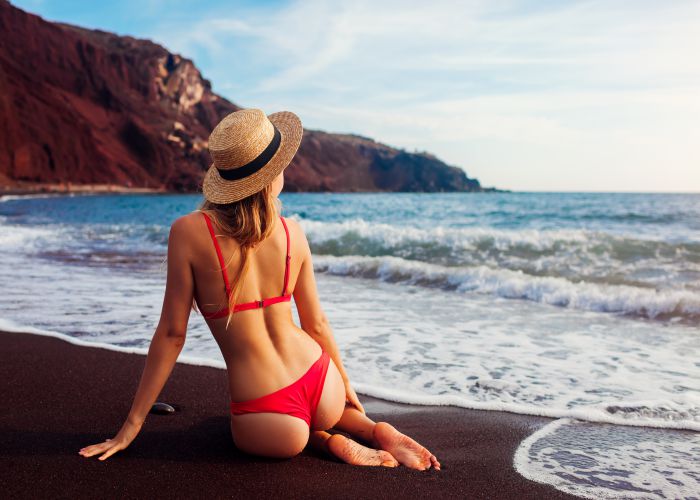
You may not see turquoise waters and golden sand beaches of the Aegean sea like the ones you've seen being advertised on the rest of the Greek islands, but that doesn't make the beaches of Santorini any less unique or exotic.
At the Red Beach, you'll swim in waters that touch a salt sand beach, with purple, almost earth-like, otherworldly sand.
And in Kamari, Perissa, and the rest of the eastern coasts of the island, you will be able to relax against the background of the large pebbles and the black sand of the island, a result of the volcanic activity.
Last but not least, the dives in Ammoudi bay, the small port below Oia, are delightful, alternative, and even more picturesque.
Of course, if you want to be close to Santorini's beaches all the time, make sure to book your stay in one of the best Santorini beach hotels! The sense of tranquility and luxurious amenities they offer are unmatched.
Visit the most unique bookstore in the world
One week of holiday on the island was enough for Oliver and Craig from Britain to decide to return to Oia to open their own shop.
Ten years ago, they transformed an empty house overlooking the Caldera into a bookstore – the first on the island at the time – and started selling rare or used books.
They also organize literary festivals, parties with dogs and cats, poetry readings at sunset, and beautiful evenings with the smell of the Aegean and freshly printed paper.
Don't miss the opportunity to lose yourself in the bookworm haven that is the Atlantis book store when visiting Oia.
Indulge in a wine-tasting experience
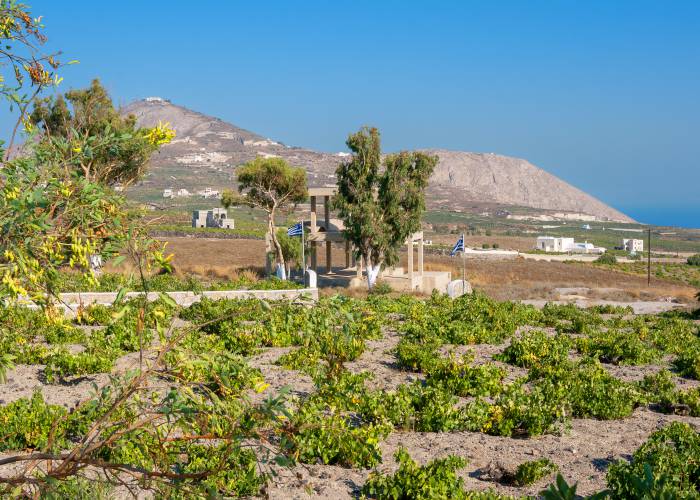
Santorini's special soil and climate offered the best opportunity to the Cycladic winegrowers, who endowed the island with a heavy tradition in winemaking.
White Assyrtiko is the main "star" of Santorini's wine production, while Athiri and Aidani follow closely behind. The famous local wine Vinsanto is an experience for the taste buds in itself.
You can try all the indigenous varieties in the small local kanaves, which are the island's traditional wineries, or in larger wineries such as those of SantoWines, Koutsogiannopoulos, Gaia Winery, Ktima Sigala, and Kanava Roussos. Of course, you will find local wine in every restaurant on the island.
Try the local flavors
It is one of the top gastronomic destinations on the Aegean, both for its food and for the restaurants and taverns with their minimalist decoration and unique view.
There are taverns and restaurants for all budgets, but it takes some research and caution because picking an overpriced establishment with not-so-great food is an easy slip-up you don't want to make.
To be sure that your money and time will be worth it, choose places with award-winning chefs, or keep reading to find out our suggestions. You can also browse our collection of handpicked Santorini tours.
The Best Hotels in Oia, Santorini

The famous island of Santorini, specifically Oia, is known for its luxury accommodation options that lure in travelers from around the world year after year.
Most rooms and suites are equipped with stunning views of the striking caldera and boast either a private pool or a hut tub.
In addition to their sheer beauty and opulence, these hotels are known for their steep prices that, however, don't make them any less popular among the tourist crowds.
Here, we have put together a list of our favorite luxury hotels in Oia, Santorini, to help you pick the one that best fits your preferences and aesthetics.
Ducato Di Oia
Resting on the cliffs of Oia, Ducato Di Oia offers its clients striking views of the volcano and the deep blue Aegean Sea, while the majority of the hotel's rooms feature a private indoor or outdoor heated plunge pool.
The establishment is tasteful and opulently decorated with words of art that, combined with the balcony of every room, make the area feel spacious and open.
In every hotel room of the luxury resort, you will enjoy a satellite, flat-screen TV, and a fully-stocked bathroom. Moreover, for Santorini's visitors' convenience, a 24-hour front desk service will make you feel safe and well taken care of.
Alta Mare by Andronis
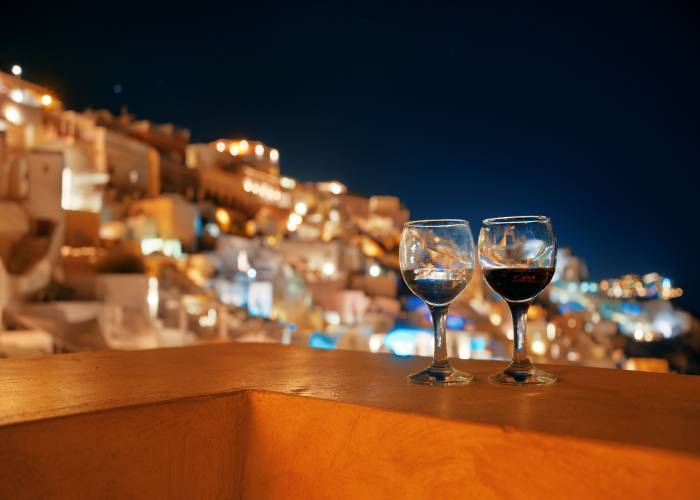
Alta Mare by Andronis is what luxury accommodation dreams are made of with its unique semi-covered outdoor pool and an open-air café offering countless hours of relaxation of fun and incredible views of the famous volcano.
Every room in the hotel is fitted with a private hot tub on its balcony, while visitors can enjoy all the comforts and luxuries they can expect from a 5-star hotel.
Atrina Canava Hotel
The biggest asset of Atrina Canava is its proximity to the beach, which is located within a 16-minute walk. The impressive hotel is in a building that dates back to the turn of the century, carved into the volcanic rock in the charming village of Oia.
Its impeccable style is enhanced by the magnificent volcano and Aegean sea views, which guests can enjoy from the pool and pool bar all day long. Every room of Atrina is equipped with a kitchenette, a living room, a satellite TV, and a well-stocked bathroom.
Art Maisons Oia Castle
Hanging off Santorini's caldera's edge, Art Maisons Oia Castle combines tradition with contemporary luxury to provide its guests with an upscale accommodation experience.
Art Maisons Oia Castle boasts the trademark Cycladic style that gives off an air of effortless superiority. While Art Maisons Oia Castle doesn't have a swimming pool, its guests are free to use the gorgeous swimming pool of the sister property Aspaki Exclusive Hotel, that offers views of the Caldera, the Aegean Sea, and Santorini's volcano.
Santorini Secrets Suites & Spa
Resting on the volcanic soil of Oia, Santorini Secrets is a 5-star boutique hotel that will steal your breath with its indulgence and striking views.
Every suite of Santorini Secrets has a large terrace with an outdoor private pool or hot tub and sports minimal decoration while staying loyal to the Cycladic aesthetic.
Of course, the hotel's guests will have the opportunity to enjoy a spacious seating area that features a flat-screen TV and air conditioning, and luxuriously-stocked bathrooms, among other facilities.
Among its highlights, are its high-quality restaurant that serves fine Mediterranean cuisine, its delicious breakfast, and its otherworldly spa that will allow you to pamper yourselves.
The best eateries in Oia
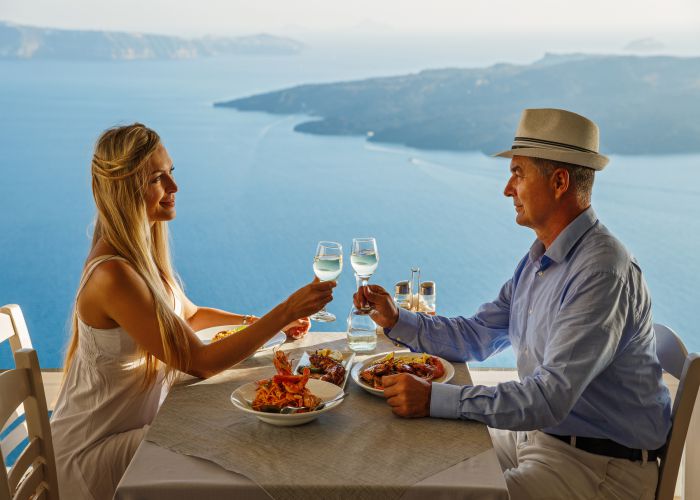
In the traditional cuisine of Santorini, we can distinguish the following ingredients and dishes:
Fava is an old traditional dish that can be served in many different ways depending on the season. What makes Santorini's fava special is the taste of fava beans produced on the island.
The local varieties of cherry tomatoes are very aromatic and tasty, while a common practice is to "dry" the tomato in the sun - the sun-dried Santorini tomatoes are something else!
Chloro cheese is a fresh goat's milk cheese, made exclusively in Santorini and, indeed, at a household level – a good opportunity to make friends with the locals!
Tomato meatballs are meatballs without minced meat, with tomato as the main ingredient and various herbs and spices. It is a delicious meze we highly recommend and that will make you drop your no-fried diet without a second thought!
The white eggplant is a type of eggplant endemic to the island of Santorini. Enjoy it in unique local dishes!

Last but not least capers and dried capers are also local products of the island and are often used in salads but also in cooking.
Oia is brimful of incredible eating establishments you should try when visiting, so picking our favorites was a difficult task. Nonetheless, here we have accumulated the best of what Oia has to offer in regard to food.
In 'Opson' at the Andronis Arcadia hotel, the award-winning chef has collaborated with an expert in the cuisine of Minoan Crete, creating a tasty interpretation of ancient Greek flavors based on the first materials and the eating habits of that time.
There, you probably won't get to eat things you've tried before. Instead, you will be served a sophisticated almond soup with sea urchin and mint, delicate, homemade smoked eel with petimezi glaze and fava beans together with fennel puree cooked in dark beer with pickled onions.

In the renovated 'Naos,' you will get to savor Japanese flavors alongside Greek and Mediterranean ideas. The sushi is to die for, and the excellent tuna tataki is spectacularly smoked in front of you.
Additionally, the mushrooms with pear, ponzu sauce, and pickled pine nuts are a very gourmet vegetarian dish, and for the grand finale, the white chocolate is masterfully combined with yuzu and other spices for an unexpected but excellent result.
What's more in the atmospheric 'Lycabettus' located inside the Andronis Exclusive hotel, your food will be complemented by an excellent cellar of fine local and international wines that will make see winemaking from a different perspective.
Don't hesitate to try the restaurant's unique dishes, such as the white asparagus "risotto" with ephemeral capsicum and oyster foam or grouper with fennel puree and strong mussels with cuttlefish ink crust, but also Greece-inspired creations, uch as cherry tomatoes with blueberries with fantastic tomato water jelly, capers, carob, and basil foam.
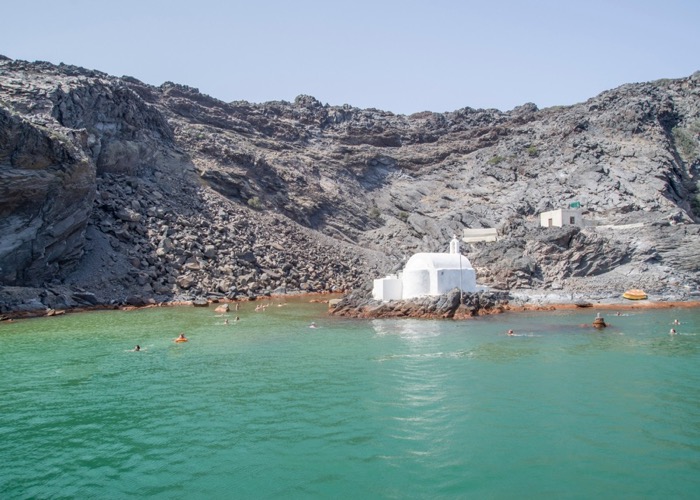
Don't leave 'Lycabettus' without tasting the traditional syrupy desert of babas, unconventionally drenched orange syrup with passion fruit and mango.
'Red Bicycle' is small, stylish, and romantic. Its chef proposes a "procho" menu, creating duets of dishes with award-winning labels of Greek oils.
The smoked eel with horseradish, egg lemon cream, and Omphacium oil stands out. Equally interesting dishes are the guinea fowl with the aromatic Pamako and the lamb that is served with a special blend of herbs.
One of the restaurants that stands out in Oia for its refined Greek cuisine is 'Black Rock' at the aforementioned Santorini Secret Suites & Spa.
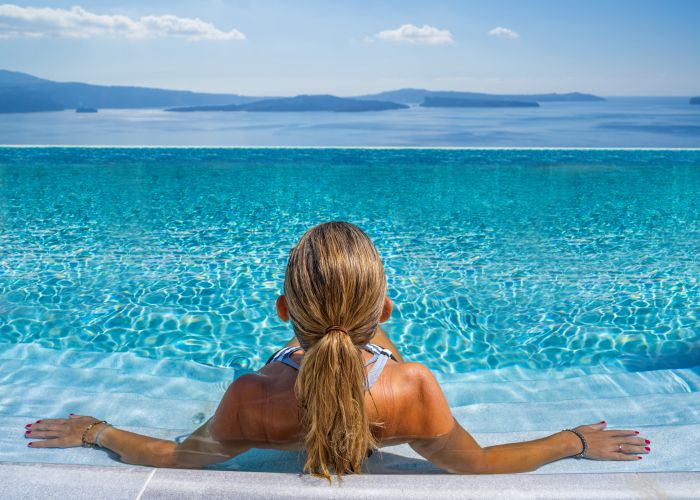
The menu hides many surprises, such as the gemista, a traditional Greek dish of stuffed vegetables made of tomato gel, goat cheese mousse, pickles and eggplant chips, Greek risotto, the sea bass stew, and also the drool-worthy baklava.
While watching the amazing sunset, enjoy some of the most special dishes you've ever tasted in 'Elements' inside Canaves Oia Epitome hotel.
Choose among the aged scallops with charred cabbage, pickled apple and roe sauce, fantastic flounder with yellow bean broth and wild garlic pesto, and, of course, the traditional sofigado with pork cheeks or the sophisticated dessert "24 carats".
The chefs at 'Petra' the restaurant of Canaves Oia Suiteshave raised the bar of Greek cuisine by serving legendary dishes, such as superfine custard cream, refined Chanio royale cake, and periope sweets, which consist of bergamot caramel with yogurt sorbet and meringues, exotic mastic with coconut and mango.
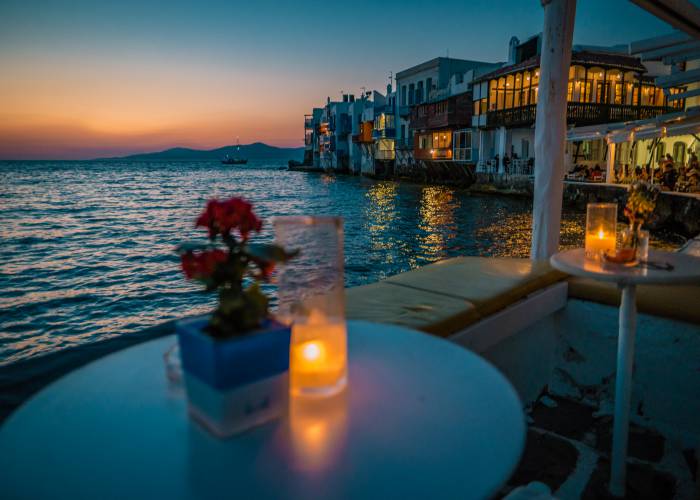
Having earned 3 Michelin stars, the chef of 'Lauda" at Andronis Boutique impresses the visitors with creations that reinvent gourmet cuisine, the fava Mille Feuille with its impressive appearance and incredible taste, shows how much the top French chef really looks for local products.
There you will also savor undercooked sea urchin royale and a bold aftertaste of coffee, beautiful lobster with fragrant bisque, and stuffed ravioli.
Last but not least, 'Alios Ilios' restaurant of Santo Maris hotel is one of the few hotel restaurants on the island that chooses a neo-urban Greek cuisine with contemporary touches and respect for tradition; the lamb fricassee of its famous Greek chef is not to be missed.
Final Thoughts
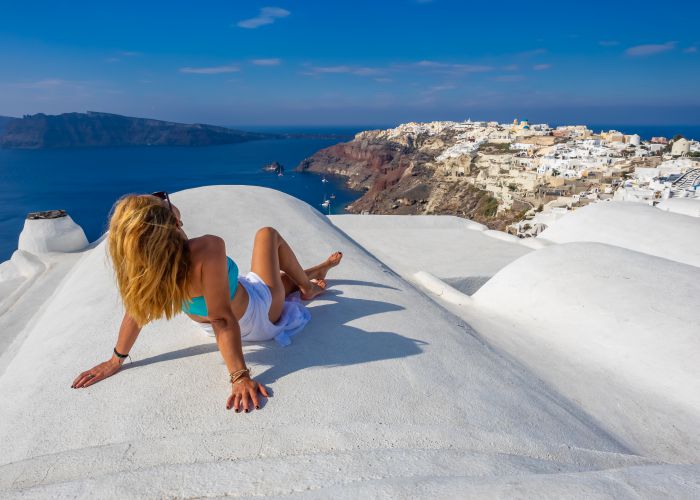
There is no doubt that when visiting Santorini, the island of Oia should be one of your first stops, especially if planning a Santorini elopement. Even if you're not staying in the area, you ought to explore it and discover why its fame has crossed the borders of Greece.
Santorini, and by extension, Oia, is a miracle of nature. Therefore, if you're lucky enough to visit Oia, see and experience it, you will leave with a bag full of happy memories and once-in-a-lifetime moments you will treasure forever.
We cannot wait for you to stand in awe before the striking sight of Oia, Santorini. It will make all the Instagram posts you've lusted after seem inadequate!
Frequently Asked Questions
What is Oia Santorini known for?
Which is better, Oia or Fira?
Is Oia and Santorini the same?
Is it worth it to visit Oia?
